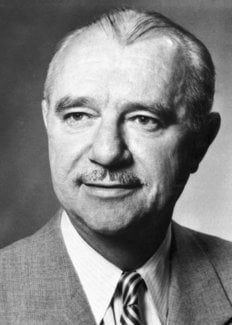Vincent du Vigneaud
Biographical

Vincent du Vigneaud was born in Chicago, Illinois, on 18th May, 1901, the son of the late inventor and machine designer Alfred J. du Vigneaud and his wife, Mary Theresa. He studied under Professor C.S. Marvel at The University of Illinois and took his B.Sc. degree in 1923 and M.Sc. in 1924.
During the year 1924-1925 he was assistant biochemist to Dr. W.G. Farr at the Philadelphia General Hospital and served on the Staff of the Graduate School of Medicine of Pennsylvania University. In 1927 he worked with Professor J.R. Murlin and submitted a thesis to the School of Medicine of Rochester University which earned him the Ph.D. As a Fellow of the National Research Council he worked with Professor J.J. Abel at Johns Hopkins University Medical School, with Professor George Barger at Edinburgh University Medical School and with Professor Charles R. Harington at London University College Hospital.
On his return to America, du Vigneaud joined the Physiological Chemical Staff at The University of Illinois under Professor W.C. Rose and in 1932 he became Head of the Biochemistry Department at the George Washington University School of Medicine. The Cornell University Medical College offered him a Professorship as Head of the Biochemistry Department in 1938.
Du Vigneaud has held many lectureships in universities in the United States and England, among the latter the Liversidge Lectureship at Cambridge, and in the summer of 1947 he was Visiting Lecturer of the American Swiss Foundation for Scientific Exchange in Switzerland. His Messenger Lectures at Cornell University in 1950 were published in 1952 as A Trail of Research in Sulphur Chemistry and Metabolism and Related Fields. Many learned chemical societies in America have conferred awards on du Vigneaud and he received the Chandler Medal of Columbia University in 1955 and the Willard Gibbs Medal of the American Chemical Society a year later. Honorary science doctorates were bestowed on him by New York and Yale Universities in 1955, and by The University of Illinois at Urbana-Champaign in 1960.
Honorary fellowships have been conferred on du Vigneaud by the Royal Society of Edinburgh, the Chemical Society and the Royal Institute of Chemistry, London. He has been elected to membership of many scientific academies among the most noteworthy being the Board of Trustees of the Rockefeller Institute and the National Institute of Arthritis and Metabolic Diseases.
His researches have centred mainly about sulphur-containing compounds of biochemical importance, being concerned originally with the sulphur of insulin and more recently with two hormones of the posterior pituitary gland-oxytocin and vasopressin. He has also studied intermediary metabolism, amino acids and peptides, transmethylation and metabolism of onecarbon compounds, transsulphuration, biotin and penicillin.
Du Vigneaud married Zella Zon Ford in 1924; they have a son, Vincent, Jr. (b. 1933) and a daughter, Marilyn Renée (b. 1935).
This autobiography/biography was written at the time of the award and first published in the book series Les Prix Nobel. It was later edited and republished in Nobel Lectures. To cite this document, always state the source as shown above.
Vincent du Vigneaud died on December 11, 1978.
Nobel Prizes and laureates
Six prizes were awarded for achievements that have conferred the greatest benefit to humankind. The 14 laureates' work and discoveries range from quantum tunnelling to promoting democratic rights.
See them all presented here.
